Hwaseong Fortress Wall
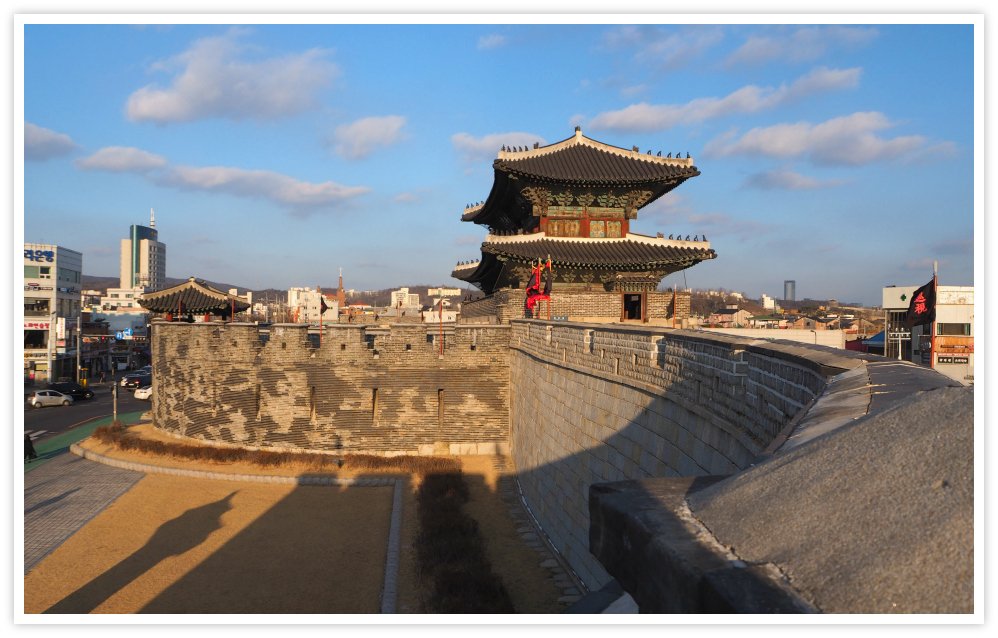 One of the gates of Hwaseong Fortress that prevented invaders from entering the town a hundred years ago
One of the gates of Hwaseong Fortress that prevented invaders from entering the town a hundred years agoIntroduction
Embark on an unforgettable journey through time as you traverse the majestic Hwaseong Fortress Wall in Suwon, South Korea.
With its imposing stone battlements stretching across hills and wrapping the city in an ancient embrace, Hwaseong Fortress is a monumental testament to Korean ingenuity and heritage.
Constructed in the late 18th century during the Joseon Dynasty, this UNESCO World Heritage site blends military practicality with an elegance that takes your breath away.
Whether you're marveling at the intricately designed gates, walking along the fortified walls, or soaking in the panoramic vistas from the watchtowers, Hwaseong Fortress immerses you in an aura of history and grandeur.
Along the way, partake in traditional Korean archery, or visit the splendid palace grounds. As the sun sets, the fortress illuminates with a golden hue, casting a mesmerizing spell.
A visit to Hwaseong Fortress Wall is not just a walk, but an adventure through history, culture, and beauty that promises to leave an indelible mark on your traveler's soul.
 At the heart of Suwon City lies the historical Hwaseong Fortress Wall.
At the heart of Suwon City lies the historical Hwaseong Fortress Wall.Hwaseong Fortress Wall
Hwaseong Fortress Wall (or Suwon Fortress) is the most famous landmark in Suwon City. It is an ancient fortress wall surrounding the center of Suwon, the provincial capital of Gyeonggi Province, Republic of Korea.
Hwaseong Fortress was built during the Joseon Dynasty by King Jeongjo to honor the house of his father, Prince Sado. The fortress is built around 30 kilometers south of Seoul, the capital city of South Korea.
In 1997, UNESCO designated Hwaseong Wall Fortress as a World Heritage site. It means that it is a treasure recognized as a heritage for all humanity.
Important reasons why you should visit Hwaseong...
- It is a beautiful sight
- It is a relaxing place
- It has hiking and strolling facilities
- It is suitable for families even with small kids
- It is very historical and amazing
- It is an excellent place to learn Korea's history since the past more than 100 years.
Yes, I will describe some of the historical records that relate to the events surrounding this historic protective wall in Suwon, later below this article.
Below are some of the photos I took during my first visit with my friends. I should say that if you want to travel to South Korea, Hwaseong Fortress is one of the places you should not miss visiting.
Being located at the heart of Suwon City, you can get various services and travel facilities you need.
The wall of Hwaseong stretches for a total of over 5 kilometers. The wall is constructed with granite stones in mostly rectangular shapes.
There are four gates for each cardinal directions – Janganmun (North), Paldalmun (South), Changnyongmun (East), and Hwaseomun (West).
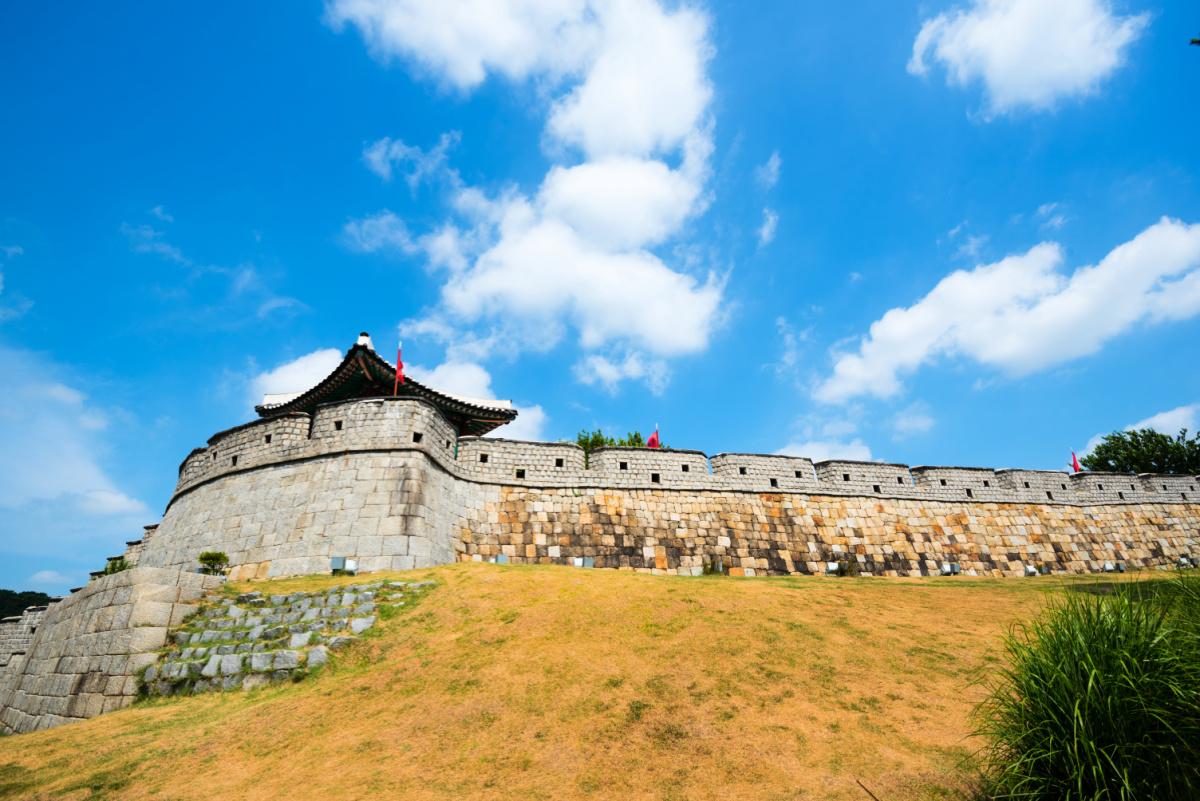 A view of Hwaseong Fortress Wall (Suwon Fortress) from outside the wall in Suwon City.
A view of Hwaseong Fortress Wall (Suwon Fortress) from outside the wall in Suwon City.the Fortress Wall
Hwaseong Fortress Wall was built under the supervision of Yu Hyeong-won and Jeong Yak-Yong. It was initially built with ‘seokjae’ and ‘jeondol’ bricks.
It was designed to strategically facilitate the use of fire guns, arrows, and spears that were being used to protect the residents from outside attacks.
Suwon Fortress suffered through varied disasters, such as during the Second World War period, which destroyed the structures and almost flattened them to the ground.
However, through great efforts for restoration in the mid-1970s, still, one can find that renovation is ongoing.
What You Can Do
There are numerous entertaining activities you can do when visiting the fortress, aside from hiking around and over and enjoying its beauty and history.
First, there is a traditional Korean archery activity. You can learn how to shoot an arrow by learning its fundamental principle. This lesson is not for free, and one can do it, starting from the age of 7 and above.
Archery costs 2,000 KRW per person for ten arrows. Who knows, you could discover your inner Legolas skill!
Second, there is a tourist trolley that is designed using the royal vehicle – the one being used by King Gojong during the Joseon Dynasty. No, you need to pay for this for a reasonable fee.
For a 30-minute trolley ride to various exciting points of the fortress, you only pay 1,500 for adults and 700 for children. A reasonable way to explore without getting tired and entertaining to kids at the same time!
Third, you can try hitting a gigantic bell – Bell of Hyowon. Its operating hours vary from season to season. The bell is located on top of Paldalsan Mountain, which is part of the wall itself.
Fourth, there is this Hwaseong Haenggung. This is within the fortress wall, which was King Jeongjo's palace. Haenggung is composed of 22 buildings and structures worth checking out.
Entering at this particular place costs 1,500 KRW per adult guest.
Also, you can ride an electric bicycle around the fortress. This is free of charge for infants who should be accompanied by adults who will pay.
Other Facilities
There are restrooms, wheelchair rental, parking areas, and benches available in some places only.
Brief Background: History & Structures
Hwaseong Fortress Wall is an impressive structure from the latter part of the Joseon Dynasty (1392-1910) and the official fortress of Suwon-si, Gyeonggi-do.
The fortress, constructed from 1794 to 1796, was built as a display of King Jeongjo’s filial piety towards his father and to create a new pioneer city with its own economic power.
Suwon fortress wall extends for a total of 5.52 kilometers. It also has a great variety of military facilities that are hard to find anywhere else in the world. Four gates face each of the cardinal directions—
Janganmun (north), Paldalmun (south), Changnyongmun (east), and Hwaseomun (west).
The 7-arch style Sumun gates balance the point where the nearby stream reaches the palace. Above the Sumun gates, you'll find a pavilion called Hwahongmun.
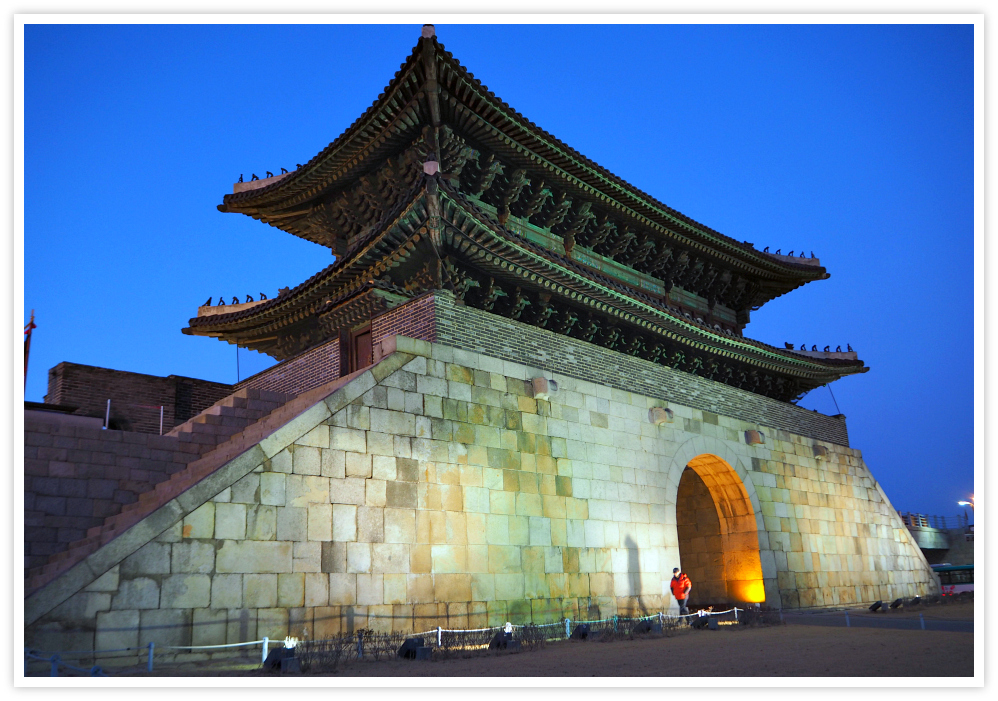 Sight of Hwaseong Fortress Wall's main gate taken in the evening before we left [Abbie]
Sight of Hwaseong Fortress Wall's main gate taken in the evening before we left [Abbie]Hwaseong Fortress Wall was constructed under the guidance of Yu Hyeong-Won (1622-1673) and Jeong Yak-Yong (1762-1836) and is believed to have been created very scientifically.
The fortress wall was built using Seokjae and Jeondol (bricks). The holes between the bricks are just big enough to fire guns, arrows, or long spears through in case of an attack.
During construction of the fortress, Jeong Yak-Yong invented ‘Geojunggi,’ which uses a ‘hwalcha’ (lever) to lift heavy stones, significantly reducing construction time.
Reconstruction Activities
The Suwon Hwaseong Fortress Wall went through many turbulent times and damage, and in the battle of June 25th, many of the facilities became so damaged that they were deemed irreparable.
Even though the fortress restoration initiative (1975-1979) restored many of the sites to their former glory, Paldalmun to Dongnamgakru (an area 491 meters in length) has still not been renovated.
The fortress was designated as Historic Site No. 3 in January 1963. And in December 1997, it was designated a UNESCO World Cultural Heritage Site.
A variety of performances and events are held at the fortress every day, and Suwon Hwaseong Cultural Festival takes place here in autumn. Seasonal festivals are best if you want a lively and colorful visit.
Services & Useful Information
Having read all the features and fantastic descriptions of Hwaseong Fortress Wall in Suwon, you probably are starting to think of visiting the place. If you, you will need the necessary information to make your travel to the area perfect!
Accessible Period
Fortunately, Hwaseong Fortress is open all-year-round to all visitors. Of course, except for some special holidays or emergency repairs and restoration works.
Besides the exceptions which rarely happen, the fortress is open to all guests of various ages. Even people with some physical disabilities can visit and explore most of its exciting nooks and corners.
Entrance Fee: 1,000 KRW
Yes, there is a minimal entrance fee to explore this UNESCO treasure site. It means that you can also freely explore by yourself as long as you want.
If you are visiting alone or with some friends or family, it would be more interesting to know something about the fortress. And if you think you need a bit more official information, you can request a guided tour which is described below.
Guided Tour Information
Basically, a guided tour activity is for educational purpose. Your group will be primarily guided to particular points in the fortress wall. The advantage of doing this is activity is that you will immediately learn the main story and information about the site.
It means that you don't need to explore the whole place, which will actually take about half a day to accomplish (if you examine every corner!).
To access that service, you can call the following phone number to book your guided tour at Hwaseong Fortress Wall in Suwon...
Inquiries: +82-31-228-3643; +82-31-290-3600
For the guided tour, you will be introduced to specific historic structures of the fortress, including...
Hwaseong Haenggung Palace, Janganmun Gate, Paldalmun Gate, Changnyongmun Gate, Hwaseomun Gate, Hwahongmun Gate, Namsumun Gate, Seojangdae, Suwon Traditional Culture Center, Suwon Hwaseong Museum
Hwaseong Fortress Location/Address:
910, Jeongjo-ro, Paldal-gu, Suwon-si, Gyeonggi-do
경기도 수원시 팔달구 정조로 910 (장안동)
Current Status: Historic Site No. 3 (Designated on January 21, 1963)
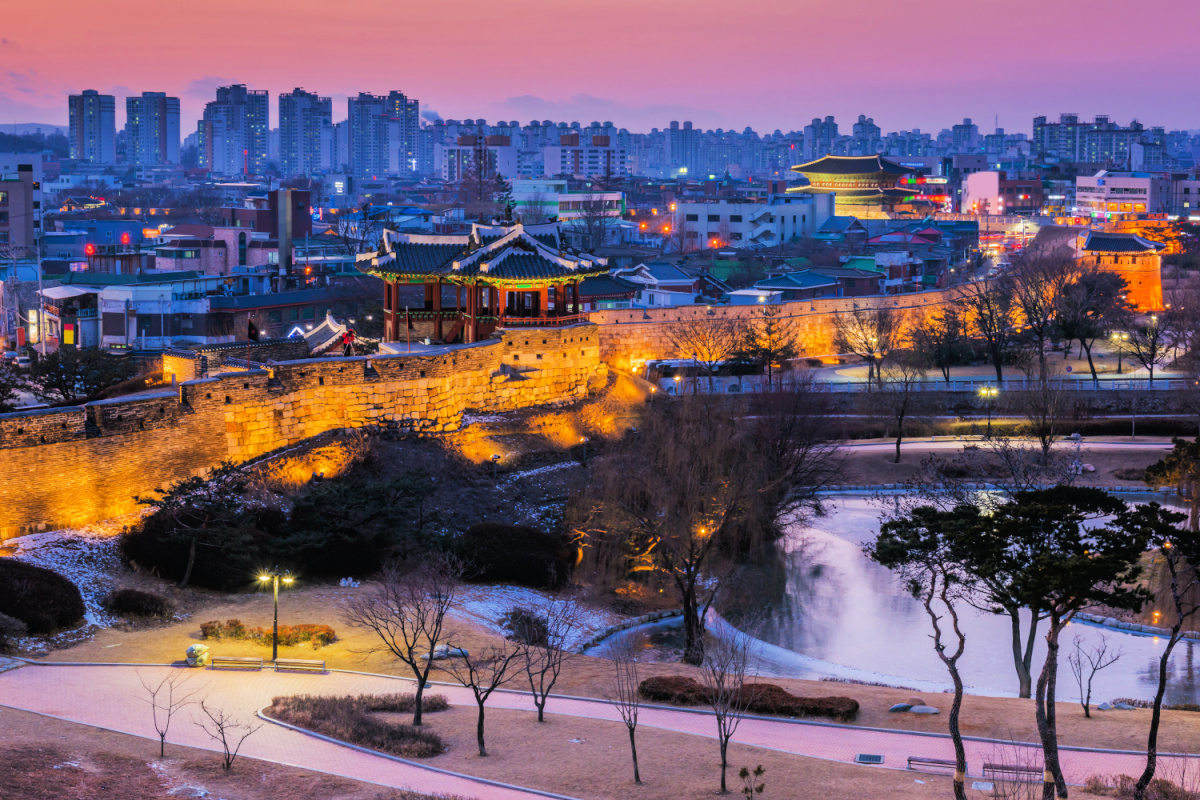 Suwon City in the evening with Hwaseong Fortress in the foreground.
Suwon City in the evening with Hwaseong Fortress in the foreground.Getting to Hwaseong Fortress Wall
Public transports in South Korea are very efficient and comfortable. Besides, the fares are inexpensive, including the taxi if you compare with taxis in other countries.
By Subway
From your point of departure, get to where you can transfer to Subway Line 1. You can download an app or get a guide map (if possible, please don't use paper for the sake of environment ^^).
Get off at Suwon Station (Line 1) and follow the sign for the fortress. You need to cross the street after you exit the station to get a bus.
Buses 5 or 7 will bring you to closer to Hwaseong Fortress Wall. Get off at Jangan Park Bus after a 15-minute bus ride. Hwaseong Wall Fortress is on your right as you get off.
To Suwon Station, you can take the same bus by crossing the street where you got off. Since going to the subway station is a busy route, you can also find other buses ferrying passengers toward that direction.
Now, I guess that enough for now. If you have questions or any, please send me a message.
Have fun and keep safe in your travels!
- Home
- Gyeonggido Attractions
- Hwaseong Fortress Wall
Get Exciting Activities
Book one of our exciting activities today to experience the thrill of a lifetime! Take advantage of this opportunity and secure your spot in advance.
Hotel Map Guide
Find your affordable, accessible, and comfortable hotel in Seoul at Agoda.Com. See the hotel map below...
Hotel Booking Guide
Find affordable and amazing hotels on Agoda.com using the search box below. Book now to enjoy great discounts and save!
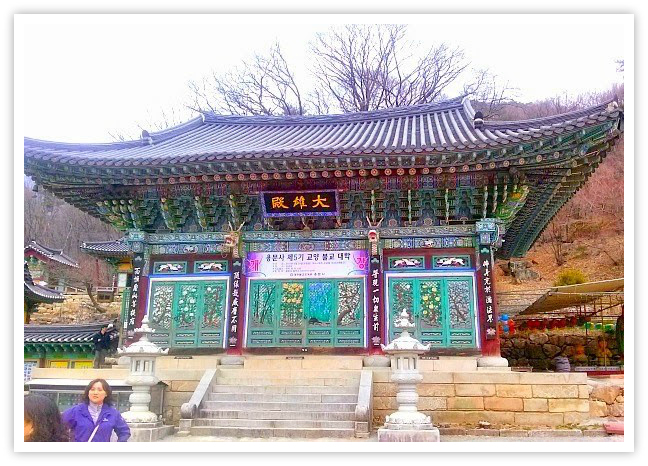






New! Comments
What do you think about this page? Leave me a comment in the box below.